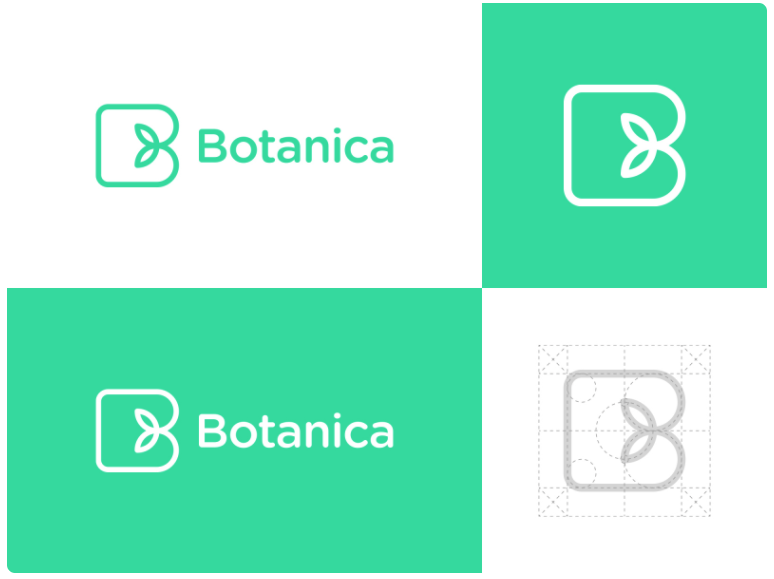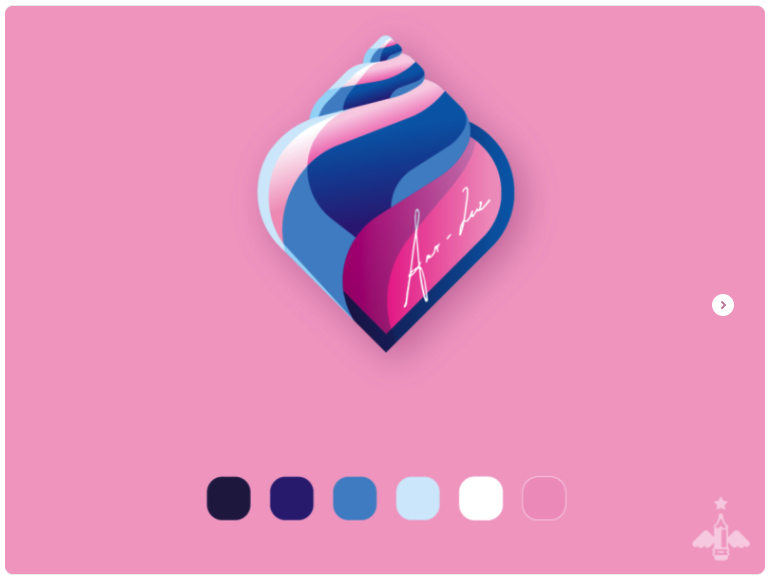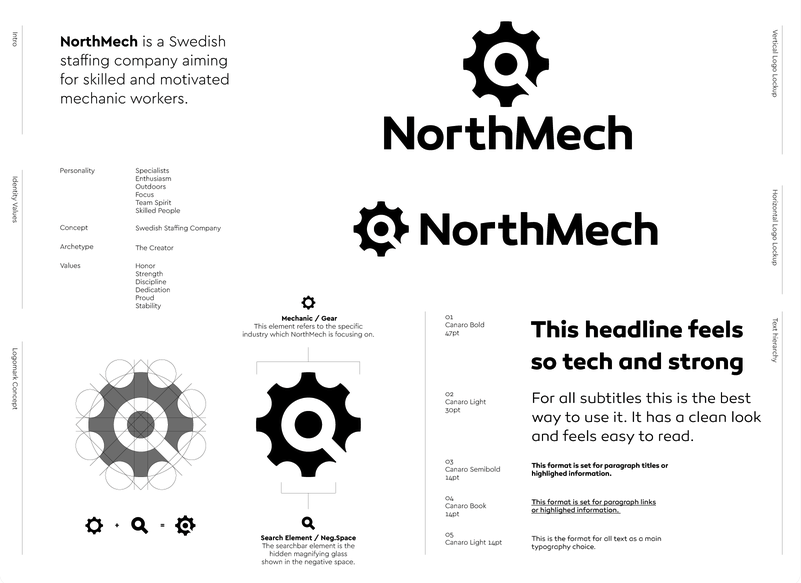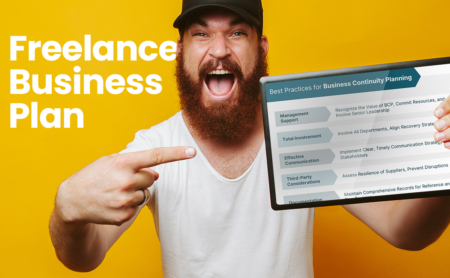Mastering how to present a logo to clients can take years of practice and experience.
Plus, there’s the pressure of getting a client logo presentation right the first time in order to avoid starting over or frustrating your client.
While a logo technically should stand on its own, my friend and logo expert Ian Paget perhaps put it best:
“I’ve learned through experience that how you present your design work is as important, if not more, than the physical design phase.”
With that in mind, I reached out to Ian, who runs a wonderfully successful logo design company in the UK and asked for a favor.
Could he connect me with dozens of talented logo designers to answer the question of how to present a logo to a client successfully?
What I got back was a collection of incredible advice from experienced logo designers who have been designing logos and presenting them to clients for years.
That means, instead of slogging through learning how to present a logo from scratch, you can learn from some talented and experienced logo designers exactly how to present a logo for the highest chances of client satisfaction.
- When presenting a logo, keep it simple. Present only your best design option(s).
- Explain how your design choices align with the client’s brand and goals.
- Consider using mockups to show how the logo would look in real-life scenarios.
Below are some of the most helpful responses I received. I hope they’ll prove useful as you perfect how to present a logo to your own clients.
1. Start with the logo design brief
The success of your logo presentation to a client starts long before you sit down to present your logo.
The real secret of how to present a logo begins in your initial meetings with clients when you send a proposal and agree on a creative brief.
Then, presenting a logo to a client becomes a matter of showing them how your design fulfills the requirements you both agreed on earlier in the process.
Here’s what a few expert logo designers had to say about how to present a logo according to the design brief:
Always start with a detailed design brief. If the client doesn’t provide you with one, create your own by asking the right questions. Once you have created a brief, get the client to approve this before starting anything.
As part of my logo design process I create a tick-list of objectives by asking questions. I then ask the client to check and approve this list.
This approach ensures that we’re both on the same page from the outset, and that I have goals to refer back to when presenting my work.
—Ian Paget, LogoGeek
Before presenting I start with a conversation. I tell them what they are going to see, and how I will explain the reasons behind the work. I talk about research and reiterate what the creative brief outlines.
—Susan Feinberg, Fireside
Take them through the logo design process and show them how your concept meets their criteria.
—Col Gray, PixelsInk
Refer back to the brief to show your understanding of their brand and requirements.
—James Mortimer
AdvertisementAdvertise HereStart with the end in mind – the goal – then repeat the brief, linking to aspirations they have for their company/brand. Then take them through what you will be presenting and your thought process for each.
—Danny Matthews, Danny & Co.
The most important thing is that the client can see how the solution delivers the strategy.
—Iain Hamilton
2. Make the logo presentation in-person or via video
Another suggestion on how to present a logo that came up over and over again in our group of experts was to make your logo presentations to clients in-person (or online), not via email.
Part of mastering how to present a logo is being able to gauge client reactions on the fly and adapt to a wide variety of responses. This proves near impossible when you simply present a logo via email.
Taking time to prepare a logo presentation that you make “in person” also shows you care about how you present the logo and that you believe in your final logo design.
Here’s what a few of our expert logo designers had to say about how to present a logo in-person (or via video):
My best advice is to always present [the logo] face to face. Never just send a file… It’s a simple one but also one of the most important things, in my opinion.
—Mads Haakansson, N’fellows
Have structure to the presentation and always do it in person/live, instead of email.
—Danny Matthews
If you’re presenting the logos over skype or Zoom, do not send the presentation document to the client ahead of the call, instead present the logos document to them page by page and talk them through what they are seeing.
—Ben Stanbury – Prosper
AdvertisementAdvertise Here
3. Tell a compelling story about the logo
Learning how to present a logo to a client is as much about storytelling as it is about professional presenting skills.
In fact, a story will often get you much further with a client than a stiff, executive-style presentation ever will.
Your story should present the problem the company or its customers have faced and how the new logo solves many previous issues.
Here’s what some of our experts had to say when it comes to using storytelling when presenting a logo:
Tell the story behind the logo and it’s meaning. Touch on how it meets their criteria and how you see it resonating with the target market. Make sure to summarize that story as a simple blurb in the presentation, so the client can reference it as they deliberate.
—Rachel Stoneking, Stoneking Design
Take them on a journey. Tell a meaningful story both visually and in writing.
— Craig BurtonMake a little animation or GIF to explain the story of the logo. This makes your client’s life easier as they explain further to all other stakeholders.
—Mohak AhujaTell their story. Show how you’ve listened and interpreted their core. Show them that you understand and share their vision and goals. The craft and implementation can come later in the presentation but they need to believe you’ve ‘got it’.
— Jonathan Harris, Harrisment
4. Include mockups & provide context
In addition to telling a story and showing how your logo solves the client’s problem-at-hand, you’ll also want to learn how to present a logo in context by providing real-life scenarios and mock-ups.
By presenting a client’s logo in real-world settings (like on their products, on business stationary, or in advertisements), your client will be more likely to envision the strength of the new logo you’re presenting.
Here’s what logo presentation pros told me about harnessing the power of logo mockups:
Include mockups to show the logo in use in real world situations and not just on an empty white page. Many people need help with visualising their logo in use and it really helps to sell the design.
— Col GrayGive the logos some context. Whether that’s on the back of a business card, or the side of a building. It will help them understand how their new brand is going to work in the real world.
— Simon Potter, Pixels & PaperShow them how the logo will be used in real life and suggest an application they may not have thought of relating to their aspirations. So if they would love to bring out a new product in future – show how that would look in real life to give longevity to the designs.
—Danny Matthews
Showcase the logos on mockups! Be sure to use the typical business stationery mockups, but also include a few that are relevant to the clients and their industry. Mockups are a great way to show clients how their new logo will work in the real world.
—Rachel Stoneking
Choose some selected key visuals/mockups of their identity in action. Get them to buy into themselves and their audience using and experiencing the new scheme.
—Jonathan Harris
You have to present [the logo] in context, and build on a story that the client will embrace. All of this stems from understanding the business, the culture, and the brand to help establish the right design for the right narrative.
—Tony Lopez
5. Show off the logo’s versatility
In addition to presenting mockups of the logo’s potential usage, it will be helpful to show how versatile your logo can be.
Learning how to present a logo in a wide variety of ways will help your client see how flexible and timeless your new design is. It will help them see exactly why you charge good money for logo design.
Here’s what some of our logo design pros said about versatility:
Present it in as many ways as you can. Show it big, small, white only, black only. Show it embroidered, screen printed, embossed, glossy, matte. Show it on a mug, a hat, a t-shirt, on paper, on a car, on a billboard, in a newspaper… you get the idea.
The point is to show them the versatility of the logo. Show that you’ve put in enough thought on the design that no matter the situation your design is going to work for them and not be something they need to “find a solution for” down the road.
—Mike Pickett
Don’t just show it large, show it tiny too. Large is impactful, but small shows it has range. There’s no point progressing a design that doesn’t work at 100px wide.
—Mark Bowley, Bowley Design
6. Focus on the audience
Throughout your entire logo design presentation, you want to focus on the logo’s audience.
The audience is often not the client you’re presenting the logo to, but their customers or clients. So while it may be tempting to talk about how much your client should like your new logo designs, learning how to present a logo with the right audience in mind is critical to your success.
Perhaps one of the most critical pieces of advice was given by logo designer Ben Mottershead from Ben Designs: “Always show the logo as it would be seen by an audience.”
That means as you’re presenting mockups or highlighting the versatility of your new logo design, make sure you highlight the new logo from the perspective of the most important audience: your client’s customer.
You may find you need to remind your client to judge the new concept based on the audience, as I was reminded by designer Darius Enache: “Tell them on what criteria they should judge the logo (functionality, not personal preference).”
Show customers using products with the new logo. Show team vans parked on streets with the new logo plastered on the side. Mock-up a banner to see what the logo might look like at a major convention.
Putting the audience first through the entire process will be critical as you learn how to present a logo successfully.
3 Logo presentation templates for inspiration
To help your logo presentations and spark some ideas, here’s 5 designs done from experts showing you how it’s done.
Grid logo presentation by Gennady Savinov
In this logo presentation, designer Gennady Savinov created a simple, yet effective grid layout to show both color variations. Additionally, he included the logo spacing spec for added visuals. This layout quickly and easily shows the client your design concept.
Single logo presentation by Angie Mathot
This beautiful logo presentation lets the main logo shine. With the on-brand background color, and the added color palette squares at the bottom, it’s a really well-done logo presentation to impress your clients with. Clean, simple, and does what it’s supposed to!
Detailed logo presentation by Jeroen van Eerden
In this logo presentation design, designer Jeroen van Eerden created a one-pager full of info. This gives a breakdown of who the company is, what they’re about, the logo design variations, and the typography to be used. Although it’s a little busy, this style can be super informational and useful for relaying brand guidelines.
Mastering how to present a logo
The truth is, you won’t be perfect at presenting logos to clients overnight. And that’s ok.
But with time, and using the advice of the expert logo designers above on how to present a logo, you’re way ahead of the competition.
In addition to the advice shared above, Steve Evans from Sed+Co urges, “Make sure you … tell them to sleep on the concepts. Far too often clients are too quick to pick an option. Once they’ve gained some distance from the initial excitement, they’re mind is clearer to make an informed ‘business minded’ decision.”
And, of course, perhaps the most important advice for anyone wanting to learn how to present a logo comes from designer Liam Jackson:
“Only present designs you’re happy with. (We all know why 😅 ).”
For anyone who doesn’t know (yet), there’s an unwritten law in logo design that the client will always, ALWAYS pick the design you like the least.
So when presenting logos to clients, never show them something you’re not happy with yourself.
With that, you’re ready to go. All of us wish you the best of luck on your next logo design presentation!
Keep the conversation going...
Over 10,000 of us are having daily conversations over in our free Facebook group and we'd love to see you there. Join us!








All of these are highly appreciated and remarkable client dealing strategies. But I have a query, what if you get some really annoying client who is not willing to show any interest in that design you made with full dedication and hard work. I was in a trouble last month when this type of situation happened to me and after all the efforts, I was no excuse for my services I provided him. However, nice post and I’ve learnt a lot from this.
Thank you for this great article. It is very important to provide clients with more than one logo concept for them to be satisfied with the service you have offered. This gives them a chance to choose from different styles and options.
Offering clients free revisions will also win clients over.
I just want to know how designers deliver the logos to the client? By email? By jump drive?
i see that a lot of logo designers who post their work online present their work on business cards or a large wooden panel. Especially for compete branding packages. How do they do this?
Focus should be on the logo and not presenting it on different material or backgrounds. That stuff comes later. The logo should be on a white background and free of clutter and other distractions. what your talking about is a brand identity which comes with big budget clients and possibly after they select one of the designs.
I’m not in agreement with this. A logo is never seen in isolation, so why present in this way? I think a logo needs to be tested in application by the designer, and also presented in this way too. I personally present the logo on its own as you mentioned, together with a few slides showing it in use as it helps to sell the design. There’s lots of really cool tools out there to make this a quick/easy process.
Awesome article. I love being able to explain “why” I create a logo the way I do and the elements I choose to include. It does double duty as showing the client that I was listening to their wants and it serves as a barrier to keep me from including irrelevant information or elements. Again, awesome post!
Your article covers almost all points.But I want to know to make a attractive background and portfolio that can help me getting more clients.I make good logos but problem comes while showing them .please help
Great article, nice tips! The first impression is so important, that there’s no room for bad logos. Unfortunatelly it is sometimes hard to convince clients of the solution that would be the best for them.
Nice article. Anyone that is presenting full web designs should remember to create a “mockup” of their work that your client can view in a browser with a background.
Very good post, awesome read, thanks
To echo Shea’s comment, Murphy’s law applies here. If you include a logo you are not 100% pleased with, the client will pick that one. Also, if you are working with an AE on the project, be sure to sit down beforehand and explain your reasoning so they can appropriately champion your work to the client. If you don’t work together as a team, it will make everyone look bad, not just the design. Great article Preston!
– “Present practical application”
Very often their first reaction is not so good when you showed them JUST logo. Then you put in on the business card, stationery, t-shirt, whatever – and they love it.
Most people perceive things depending on their surroundings :).
@Michal Kozak,
That is a very good point! It seems that the client is always more impressed when you go the extra mile to help them understand application of the logo. Thanks for adding.
Sure do all that work but make sure your getting paid for all that additional work. That stuff comes after they decide on one of the concepts. Also the proper way is to have them pic a logo and if there are additional revisions, then you move to all that jazz with business cards etc.. You only do that if they pay for it, not to win them over. Your logo should do that by itself.
Nice Article. The first impression counts!
The “why” factor is always acting as the main principle in my presentation. From my experience: the more time you spend and efforts give to writing presentation the more positive client’s reaction is. So obviously sometimes it’s just not enough for a result and then it comes to how good you can be at explanations of your decisions.
And never present something that you don’t love. If it’s just okay… It it’s your least favorite… If it’s one one that you did just to illustrate how much better of an idea the others are, It is guaranteed that the client will pick that one.
YES! THIS CANNOT BE OVERSTATED! It has proven true SO many times.
It must be your best pick. Nice one Shea.
Correct!
Nice tips! The way we present the logos might be 50% of success. We can drive the client’s mind to what we want 🙂
wicked article. You defiantly hit the nail on the head with a lot of those points. A lot of what I have read says that how you present your concept is just as important as what you present to a client.